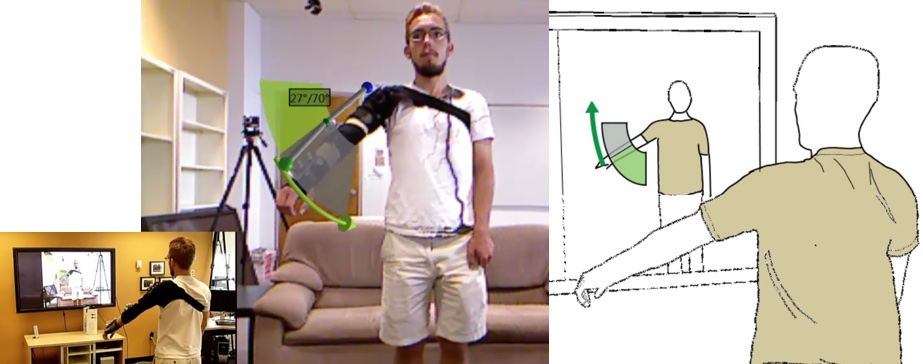Physiotherapy for the Future
Helping the rec sports weekend warrior overcome injury

Many soft tissue injuries are well-suited for physiotherapy intervention – for instance, overuse of a shoulder, or tweaking a knee, etc. Our interest is in designing tools to support these interventions. In one exploration, we studied how to design tools for remote physiotherapy, where a client can “visit” and work with a physiotherapist via a remote video connection (Ledo, Aseniero, Greenberg, Boring, & Tang, 2013; Dillman & Tang, 2013). This exploration present new challenges for conventional videochat applications, and we designed tools to overcome these challenges.
Nevertheless, we found such “visits” would still need to be augmented with at-home interventions that could support guidance on exercises, where people could be reminded of and guided to perform an exercise properly. We explored several visualization techniques for providing this feedback (Tang, Yang, Tang, Bateman, & Jorge, 2015; Tang, Alizadeh, Tang, Bateman, & Jorge, 2014).
Publications
Richard Tang, Xing-Dong Yang, Anthony Tang, Scott Bateman, and Joaquim Jorge. (2015). Physio@Home: Exploring visual guidance and feedback techniques for physiotherapy patients at home. In CHI 2015: Proceedings of the 2015 SIGCHI Conference on Human Factors in Computing Systems, ACM, 4123–4132. (conference).
Richard Tang, Hesam Alizadeh, Anthony Tang, Scott Bateman, and Joaquim Jorge. (2014). Physio@Home: Design Explorations to Support Movement Guidance. In CHI EA ’14: CHI ’14 Extended Abstracts on Human Factors in Computing Systems, ACM, 1651–1656. (poster).
Acceptance: 49% - 241/496. Notes: 6-page abstract + poster..
Kody Dillman and Anthony Tang. (2013). Towards Next-Generation Remote Physiotherapy with Videoconferencing Tools. Department of Computer Science, University of Calgary. (techreport).
David Ledo, Bon Adriel Aseniero, Saul Greenberg, Sebastian Boring, and Anthony Tang. (2013). OneSpace: shared depth-corrected video interaction. In CHI EA ’13: CHI ’13 Extended Abstracts on Human Factors in Computing Systems, ACM, 997–1002. (poster).